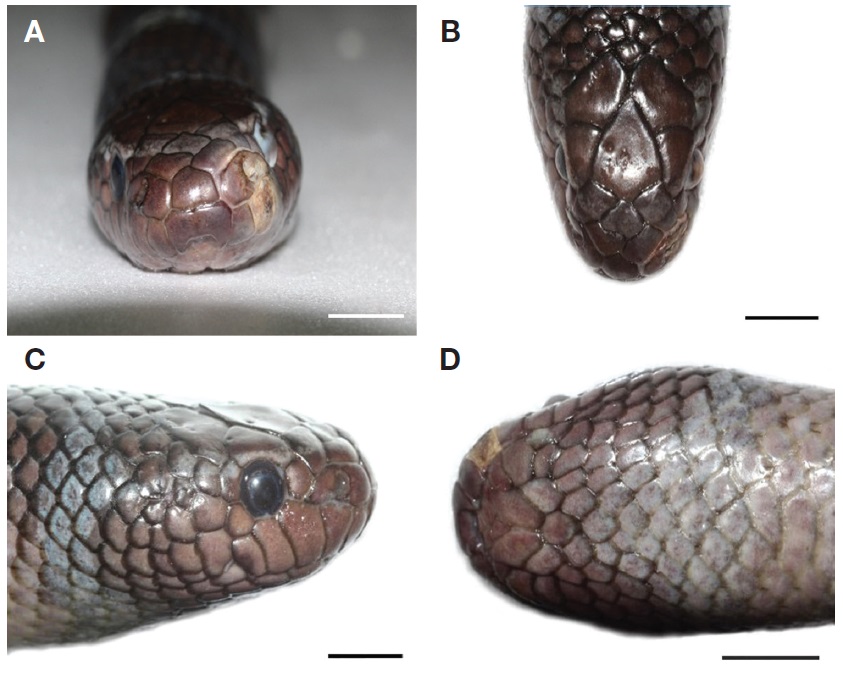



Globally, 70 sea snakes (aquatic elapids) of 8 genera in the two subfamilies Hydrophiinae and Laticaudinae have been reported in the tropical and subtropical waters of the Indian Ocean and the Pacific Ocean from the east coast of Africa in the west to the Gulf of Panama in the east (David and Ineich, 1999; Rasmussen et al., 2011; Reptile Database, 2015). In East Asia, which includes Taiwan Province of China, Japan, China and Korea, 16 species (13 in Hydrophiinae and 3 in Laticaudinae) have been listed (Dunson, 1975; Kang and Yoon, 1975; Mao and Chen, 1980; Heatwole, 1987; Szyndlar and O, 1987; Zhao and Adler, 1993; Goris and Maeda, 2004).
In Korea, three sea snake species have been reported based on anecdotal capture cases and newspaper reports, and they are all within the Hydrophiinae subfamily (the Yellow-bellied sea snake
In this study, we report the Chinese sea snake
The specimens were collected from Gangjeong-dong (33°12′58.08″N, 126°29′19.23″E), Aewol-eup (33°27′54.2″N, 126°16′59.7″E) and Namwon-eup (33°15′10.00″N, 126°42′50.00″E), Seogwipo-si, Jeju-do by fishermen (Park YH, Ko YS, and Shin CY) on 26 Aug, 17 Sep and 3 Nov 2015, respectively, and they were transported to the Herpetology Laboratory of Kangwon National University. The snake from Aewol-eup died on 17 Oct 2015 of unknown causes during indoor captivity and the snake from Namwon-eup was sacrificed by the fisherman on the collecting site. They were collected, with one being preserved in 10% neutral formalin and the other in 95% EtOH before being deposited into the herpetological collection of the University (G470LS, G475LS in order). The snake from Gangjeong-dong is being kept in an indoor pool (4.5 m long, 2.2 m wide, 0.84 m high, and 8 cm water depth, G469LS). We measured the snout-vent length and tail length of the specimens using a tape ruler accurate to within 0.1 cm, and the body weights were measured using a digital balance (ELT 4001; Sartorius-Korea, Seoul, Korea) accurate to within 0.1 g. We classified the specimens following Mao and Chen (1980) and Rasmussen et al. (2011). Photographs used in this study were taken with a digital camera (EOS 600D; Canon, Tokyo, Japan), and the brightness and contrast of the photographs were adjusted in Photoshop (ver. 12.0).
>
Material examined. 3♀, Korea: Jeju-do: Seogwipo-si, Gangjeong-dong, 26 Aug 2015, hand net on water surface, coll. Park YH (G469 LS); Seogwipo-si, Aewol-eup, 17 Sep 2015, hand net on water surface, coll. Ko YS (G470 LS); Seogwipo-si, Namwon-eup, 3 Nov 2015, hand net on water surface, coll. Shin CY (G475 LS).
Description. Ground body color pale blue (Fig. 1A), ventral color yellowish (Fig. 1B), upper lip color bluish-brown or pale-blue (Fig. 2A), stripe color light brown to gray (Fig. 1A, B). Stripes ‘V’ shaped (Fig. 1B), being broader dorsally and tapering toward the belly. 36, 34, and 37 stripes on body and 7, 6, and 6 on tail, respectively, in the Gangjeong, Aewol, and Namwon specimens. Rostrals horizontally divided into two, smaller upper scale lies between nasals (Fig. 2A), two internasals, three prefrontals, one frontals and two parietals (Fig. 1B), excepting in Namwon specimen, one of three prefrontals separated into two. Seven supralabials of which the 3rd and 4th touch the eye, one supraocular, one preocular and two postoculars and 2+3 temporals on each side of the head (Fig. 2C). One mental and 7 infralabials (Fig. 2D) excepting Gangjeong specimen six supralabials on the left side. 199, 202, and 199 ventrals; 35, 36, and 36 subcaudals; 2, 2, and 2 anals; 21, 23, and 23 dorsals on the neck; 21, 23, and 23 dorsals on mid-body; 21, 21, and 21 dorsals near anal opening; 78.7, 103.0, and 96.5 cm snout-vent length; 12.9, 13.8, and 12.8 cm tail length; and 841.2, 750.9, and 736.1 g body weight for the Gangjeong, Aewol and Namwon specimens, respectively.
Distribution. Far East Maritime Reserve (Peter the Great Bay, Japan Sea), Yellow Sea, Japan (Ryukyu Islands), South Chinese Sea, Taiwan, Philippines, Indonesia (Mao and Chen, 1980; Zhao and Adler, 1993; Kharin and Czeblukov, 2006; Rasmussen et al., 2011).
Remarks. All sea snakes have a prominent vertically flattened, paddle-like tail (Fig. 1A, B). Although the genus name,
Our study is the first detailed description of any of the sea snakes in Korea and also the first capture report of Laticaudinae sea snakes from Korean waters, resulting in total four sea snake species listed in Korea. Considering that reports on sea snakes in Korea are very rare and global warming is continuing (Poloczanska et al., 2013), further updating of information on Korean sea snakes is strongly suggested. Accumulating more sea snake samples and analyzing their originalities using various molecular markers could elucidate if Laticaudinae sea snakes inhabits all the year round in Korean waters and also, might allow us to determine possible drift or immigrant routes of the sea snakes found in Korean waters.
>
Key to the species of Laticaudinae and Hydrophiinae in Korean waters
Laticaudinae. Ventrals much wider than adjacent dorsals, approximately 4 times as broad as long.
Hydrophiinae. Small ventrals, each not more than twice as broad or similar to adjacent body scales.
Korean name:1*큰바다뱀아과 (신칭), 2*큰바다뱀속 (신칭), 3*넓은띠큰바다뱀 (신칭)



